Yet who shall declare the dark theme a positive handicap? Radiant with beauty, the Cup of the Ptolemies was carven of onyx.
– Supernatural Horror in Literature, H. P. Lovecraft
Comics and its continuities have long been happy receptacles for H. P. Lovecraft and his machinations. Noah’s appreciation of the author’s “ham-fisted” charms can be found in the archives of this site together with a review of a predictably mediocre adaptation, the Eureka Graphic Classics production of H. P. Lovecraft.
The adaptation of The Dunwich Horror by Norberti Buscaglia and Alberto Breccia is a more distinguished example which found its and first and only translation in the pages of the October 1979 issue of Heavy Metal. For the uninitiated or forgetful, the story concerns the mysterious and possibly inbred Whatley family; in particular the newly born, preternaturally intelligent child of unknown paternity, Wilbur Whatley, a veritable Baphomet. Ugly, wicked, and inhuman in anatomy, he is slain mid way through the narrative allowing investigations to begin under a certain Dr. Henry Armitage. Occult books are consulted and cryptograms decoded even as a mysterious force lays waste to the small town, slaying whole families in the thick of night. A final confrontation occurs on the hills of Dunwich where Wilbur’s monstrous twin brother is defeated and unmasked.
The presentation in the English language Heavy Metal is more than aptly named considering the debasements inflicted on it over the course of the production process.
[Spanish and English editions of The Dunwich Horror]
Yet even in the original, this seems to be a job approached with proficiency by Breccia rather than the excitement and innovation one finds in a work such as Rapport sur les aveugles (Breccia with Ernesto Sábato). Lovecraft’s slow meanderings (the delays, forebodings, and suspicions) don’t lend themselves well to the narrative ease found in comics adhering to classical forms. It must be said though this adaptation was probably never meant as a substitute for the original but as a sort of primer and graphic aide. It may be that even a moderately long short story of this ilk would probably need twice as many pages to achieve its desired effect. Examples of this watering down may be seen on every page. The secret rites practiced by mother and child seem strangely innocuous and are not followed by the ambiguity of a witness’ testimony that the child had:
“…some kind of a fringed belt and a pair of dark trunks or trousers on” and that “Wilbur was never subsequently seen alive and conscious without complete and tightly buttoned attire, the disarrangement of which…always seemed to fill him anger and alarm.”
The occult sharings between grandfather and child found in the original are also omitted, these moments and their closeness suggesting not merely some demon spawn but unspoken incest and a deformed offspring (vehemently denied by Lovecraft as being too innocuous through his proxy Dr. Armitage), a parasite drawing knowledge and lifeforce from his grandfather who eventually dies by the child’s tenth year. Gone is that accumulation of fanciful and misanthropic detail: the cattle paid for in “gold pieces of extremely ancient date” which disappear (presumably consumed or sacrificed) at a prodigious rate; the town consumed by the ordinary rites of All-Hallow’s eve and Walpurgis Night; or the suggestion that “in 1917 [when] the war came…the local draft board….had hard work finding a quota of young Dunwich men fit even to be sent to development camp” and were “alarmed at such signs of wholesale regional decadence.” There are exceptions of course. The page and sequence showing the final dispostion of Wilbur Whatley is particularly excellent with its rough cut rabid cur and disintegrating form.
It occurs to me that almost all comic adaptations of Lovecraft seem to function best when seen more distinctly as illustration. The central panel on the third page of Buscaglia and Breccia’s adaptation works better than all three panels which follow it at showing Wilbur contempt for his mother, his overbearing presence like some evil Christ; the hills of Dunwich replacing that wedding at Cana and the messiah’s tarrying in the Temple in Jerusalem, an anti-Christ with altars on the high places. What better place to find a depiction of…
“…something almost goatish or animalistic”, “thick lips, large-pored, yellowish skin, coarse crinkly hair, and oddly elongated ears”
….or the corpse of Wilbur Whatley with skin “thickly covered with coarse black fur, and from the abdomen a score of long greenish-grey tentacles with red sucking mouths protruded limply” —
…or that final epiphany on the hills of Dunwich.
a “grey cloud – a cloud about the size of a moderately large building…Bigger’n a barn… all made o’ squirmin’ ropes… hull thing sort o’ shaped like a hen’s egg bigger’n anything with dozens o’ legs like hogs-heads that haff shut up when they step… nothin’ solid abaout it – all like jelly, an’ made o’ sep’rit wrigglin’ ropes pushed clost together… great bulgin’ eyes all over it… ten or twenty maouths or trunks a-stickin’ aout all along the sides, big as stove-pipes an all a-tossin’ an openin’ an’ shuttin’… all grey, with kinder blue or purple rings… an’ Gawd it Heaven – that haff face on top…’
Artful homage remains Lovecraft greatest legacy to comics, its practitioners like the aesthetes in The Call of Cthulhu, dreaming dreams and drawing monsters conceived of decades before. From that point of view, the Lovecraft issue of Heavy Metal was only making a point explicit for images from Lovecraft have ever been the center of one of the founders of that magazine, namely Philippe Druillet.
The 6 Voyages of Lone Sloane is an adaptation by any other name but here transferred to the vast emptiness of space and incalculable eons, not unlike his space faring version of Wagner’s Ring Cycle. The stories are largely nonsensical but intermittently involve forgotten fairways, secret words of power, cultic allegiances, and old dark gods—not just a testament to Druillet’s limitations as a writer, but also his singular focus on the sense of wonder and awe one finds in Lovecraft’s stories. As China Miéville writes in his introduction to At the Mountains of Madness:
“H. P. Lovecraft is the towering genius among those writers of fantastic fiction for whom plot is simply not the point.”
The imagery here is redolent of the third part of The Call of Cthulhu (“The Madness from the Sea”) in which the crew of the Emma lands on an unknown island, the “nightmare corpse-city of R’lyeh” and encounter Cthulhu himself. In not quite the same words and at various points in Druillet’s anthology of tales, we see the pirate ship Alert with its “queer and evil-looking crew of Kanakas and half-castes”…
[Images from Lone Sloane by Druillet and Watchmen by Joe Orlando]
…and then
“a coastline of mingled mud, ooze, and weedy Cyclopean masonry which can be nothing less than the tangible substance of earth’s supreme terror — the nightmare corpse-city of R’lyeh, that was built in measureless aeons behind history by the vast, loathsome shapes that seeped down from the dark stars” …where ” the hideous monolith-crowned citadel whereon great Cthulhu was buried, actually emerged from the waters.”
…before apprehending the very image of Cthulhu himself—mechanical, rampaging, and yet curiously driven away by music.
No other cartooning acolyte of Lovecraft has delineated the author’s Cyclopean landscapes quite as effectively as Druillet, an artist who has yet to show any devotion to moderation, logic or good sense to this day.
[Gail, Philippe Druillet]
Beyond this point, there is the total assimilation of Lovecraft’s innards by Alan Moore, a comic literary criticism not unlike Martin Rowson’s adaptation of The Life and Opinions of Tristam Shandy, Gentleman. Lovecraft’s madness is resolved to science in Watchmen, the stories distilled to a metaphor for creation itself. Ozymandias’ monster is the product of literature, art, and sound, a psychic wave from the future if not an alternate dimension; driving “sensitives” to distraction or outright insanity; its god-curators slaughtered and forgotten; perhaps an “origin story” for Lovecraft himself.
“It was from the artists and poets that the pertinent answers came, and I know that panic would have broken loose had they been able to compare notes…These responses from esthetes told disturbing tale. From February 28 to April 2 a large proportion of them had dreamed very bizarre things, the intensity of the dreams being immeasurably the stronger during the period of the sculptor’s delirium. Over a fourth of those who reported anything, reported scenes and half-sounds not unlike those which Wilcox had described; and some of the dreamers confessed acute fear of the gigantic nameless thing visible toward the last.” (The Call of Cthulhu)
Scattered throughout are the pirates beckoning from penny comics, the surfeit of voyages by ship, the mysterious island of genesis, the incipient insanity and death.
At other times, Moore’s concept of worship becomes less rational and reverts to the high places.
[From Hell, Eddie Campbell]
This literary dissection of Lovecraft is played out in earnest in both The Courtyard and Neonomicon, the latter’s title hinting at Moore’s own penchant to see beneath the surface to the genital horror, the unspoken orgies, and the seasoned racism of Lovecraft. Concerning the latter and the members of a New Orleans cult (shot like dogs in The Call of Cthulhu the better to control them) Lovecraft writes:
“…the prisoners all proved to be men of a very low, mixed-blooded, and mentally aberrant type. Most were seamen, and a sprinkling of Negroes and mulattoes, largely West Indians or Brava Portuguese from the Cape Verde Islands, gave a colouring of voodooism to the heterogeneous cult. But before many questions were asked, it became manifest that something far deeper and older than Negro fetishism was involved. Degraded and ignorant as they were, the creatures held with surprising consistency to the central idea of their loathsome faith.”
[from The Call of Cthulhu by John Coulthart]
These words finds their counterpart in the works of Herge and the Inca mummy in The Seven Crystal Balls of which Noah Berlatsky once wrote:
“This, then, is really a case where I don’t like the sequence despite its racism and imperialism. As far as I can tell, I like it because of them. The fascination/repulsion Herge feels towards the strange gods of colonized cultures generates real creative frisson. Which makes me wonder if maybe that’s true of racism and stereotypes in general. It seems like, beyond their other uses, they sometimes have an appeal which might be called aesthetic. A certain amount of cultural creativity goes into shaping the person in front of you into a phantom monstrosity, and that creativity can itself be exciting and fascinating. The dream’s appeal is its vividly imagined ugliness; the exhilaration of imposing on the world the gothic products of one’s skull.”
Moore’s reversal of Lovecraft’s xenophobia is patent in Neonomicon, a Lovecraft homage so thick with references that it probably demands a companion book (see The Courtyard Companion and an extensive discussion at Comics Comics). Like the tales which inspired it, the plot is all investigation, exposition, and interrogation. The art by Jacen Burrows is strangely cartoonish like a point and click video game adventure or a Saturday morning cartoon; which may seem strangely serendipitous to some, that coyness being a subset of Lovecraft’s own dread of sexual description.
The main protagonists are two FBI agents named Merril Brears (white, female sex addict) and Gordon Lamper (black male, conspicuously “normal”), the object of their investigation a cult invested in the Old Ones. The Dagon worshippers might as well be gentrified East Village baby boomers, almost everyone white as a sheet and sagging with years of excess, the new Satanism, an antidote to the privileged old biddies lacing Polanski’s Rosemary’s Baby. Where Lovecraft frequently took care to situate his cultists in distant habitations in deference to their paganism (from the Latin paganus meaning villager or country-dweller), Moore opts for the new heathens in their old squats. The only African Americans in Moore’s comic are investigating officers, a reversal of their position in Lovecraft’s stories where they are invariably abominations.
In chapter 2 of the comic (“The Shadow Out of America”), Merril strips and literally dresses like a whore in front of her black partner, all this without the slightest sexual arousal on both their parts, a counterpoint to a conversation about the “asexual” nature of H.P. Lovecraft. Gordon is duly shot and necrophilically abused once he is brought into the orgone-filled sanctum of the nearly racially exemplary cultists (the group includes an Oriental couple; a nod to the Chinamen and “unclassified slant-eyed folk” so beloved of Lovecraft ). Moore has never been shy about heavy-handed symbolism.
It is of course, stressed repeatedly that Merril is a recovering sex addict. Yet she resists her partner in a kind of temperance aided by racial purity; a chastity which repudiates miscegenation and hides from the conception of “foreign mongrels” (see The Call of Cthulhu). Far better to be coupled to a demon god for that is exactly what happens at the close of that chapter where Merril is raped repeatedly by Dagon—thus a latter day Lavinia Whatley of Dunwich who will bear the incarnation or avatar of Cthulhu. The protagonist of The Shadow over Innsmouth is of course repulsed both visually and olfactorily by the presence of innumerable half-breeds in that town; his fear of contamination realized in full at the tale’s denouement when he discovers his own mixed heritage (he is of the Deep Ones). [1]
* * *
“It represented a monster of vaguely anthropoid outline, but with an octopus-like head whose face was a mass of feelers, a scaly, rubbery-looking body, prodigious claws on hind and fore feet, and long, narrow wings behind.”
If genre is a multi-tentacled monster with a gaping vaginal maw then no one should be surprised at the mucoid sheen of Alan Moore’s countenance. These comics are concentrated deconstructions of everything treading gently on the surface of Lovecraft’s stories, far more interested in evil than mirth; a fact which separates them from metatextural films like Drew Goddard and Joss Whedon’s The Cabin in the Woods.
That film has been self-described as a loving hate letter to horror movies and a rejection of the torture porn industry. The saviors in Cabin are the classics of the genre—werewolves, zombies, marionettes, the works of Clive Barker and Stephen King et al.—once locked in a labyrinthine glass walled prison like the Minotaur but then loosed upon benighted entertainment industry moguls to the violent cathartic delight of most of the audience. Beneath that cabin and entertainment complex lies an old god destined to destroy the world and the human race. Strange then that this jocular criticism fails so completely in conveying (perhaps intentionally) any of the unease and trepidation which those idolized exemplars so hoped to challenge their audiences with. Horror for Goddard and Whedon would appear to be a place of solace and entertainment not fear, dread, and revulsion. They remain quite unconvinced by that which they write. Not for them is Lovecraft’s suggestion that:
“The one test of the really weird is simply this — whether or not there be excited in the reader a profound sense of dread, and of contact with unknown spheres and powers; a subtle attitude of awed listening, as if for the beating of black wings or the scratching of outside shapes and entities on the known universe’s utmost rim.”
Moore on the other hand is eager to translate this knowledge of depravity to us, to initiate his readers into the mysteries of authorship and creation. Together with John Coulthart [2], he imagines the Old Ones in a Kabbalistic structure where Dagon is Netzach (astringent kindness, the union of the human and divine) and Cthulhu is Yesod. The Aklo is a drug, the “Ur Syntax”, the transforming proto-human language of theophoric words, allowing us to look within to the sexual revulsion and the racial hatred; the fear of contagion and Syphilitic dementia; the horror of “cosmic sin”. His comics a mirror for the evil within our souls.
Notes
[1] Michel Houellebecq’s essay titled H. P. Lovecraft: Against the World, Against Life is quoted by both China Miéville and Tim Hodler at Comics Comics. Houellebecq denies any latent sexual symbolism in Lovecraft’s stories quoting a letter in which he writes, “I do no think that any realism is beautiful.” Here are some excerpts from the essay:
“Paradoxically, Lovecraft’s character is fascinating in part because his values were so entirely opposite to ours. He was fundamentally racist, openly reactionary, he glorified puritanical inhibitions, and evident found all ‘direct erotic manifestations’ repulsive.”
“Absolute hatred of the world in general, aggravated by an aversion to the modern world in particular. This summarizes Lovecraft’s attitude fairly accurately….if he refused all sexual allusions in his work, it was first and foremost because he felt such allusions had no place in his aesthetic universe.”
“…it was in New York that his racist opinions turned into a full-fledged racist neurosis. Being poor, he was forced to live in the same neighborhoods as the ‘obscene, repulsive, nightmarish’ immigrants…But what race could possibly have provoked this outburst [a racist diatribe describing Lower East Side immigrants]. He himself no longer knew…The ethnic realities at play had long been wiped out; what is certain is that he hated them all…His descriptions of the nightmare entities that populate the Cthulhu cycle spring directly from this hallucinatory vision. It is racial hatred that provokes in Lovecraft the trancelike poetic state in which he outdoes himself by the mad rhythmic pulse of cursed sentences; this is the source of the hideous and cataclysmic light that illuminates his final works.”
[2] Presumably a natural extension of the wild utterances of Robert Suydam in The Horror at Red Hook:
“Malone did not know him by sight till duty called him to the case, but had heard of him indirectly as a really profound authority on mediaeval superstition, and had once idly meant to look up an out-of-print pamphlet of his on the Kabbalah and the Faustus legend, which a friend had quoted from memory…When he spoke it was to babble of unlimited powers almost within his grasp, and to repeat with knowing leers such mystical words or names as ‘Sephiroth’, ‘Ashmodai’, and ‘Samaël’.”
Further reading
(i) The French edition of Les mythes de Cthulhu (drawn by Alberto Breccia) – The gold standard for comic adaptations of Lovecraft. One of the greatest artists to grace the comics form. I suspect Breccia’s adaptation of The Dunwich Horror was chosen for translation by Heavy Metal magazine because it is also the most “conventionally” drawn. The rest of the stories in this collection are more experimental in technique. Breccia’s depiction of Cthulhu and the Deep Ones is also typically unusual.
(ii) The Lovecraft Anthology Volume 1 (SelfMadeHero) – This is the PG-rated version of Lovecraft by a host of British artists. Low on evil, mystery, racism, and violence, this is for the Scooby-Doo set. Give this one to your kids.
(iii) Haunter of the Dark – John Coulthart is the way to go if you’re an adult.
(iv) Yuggoth Cultures – a smattering of Lovecraft ephemera from Alan Moore. Antony Johnston’s Yuggoth Creatures demonstrates what a mediocre pastiche of The Shadow over Innsmouth (and others) would look like.
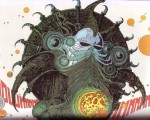
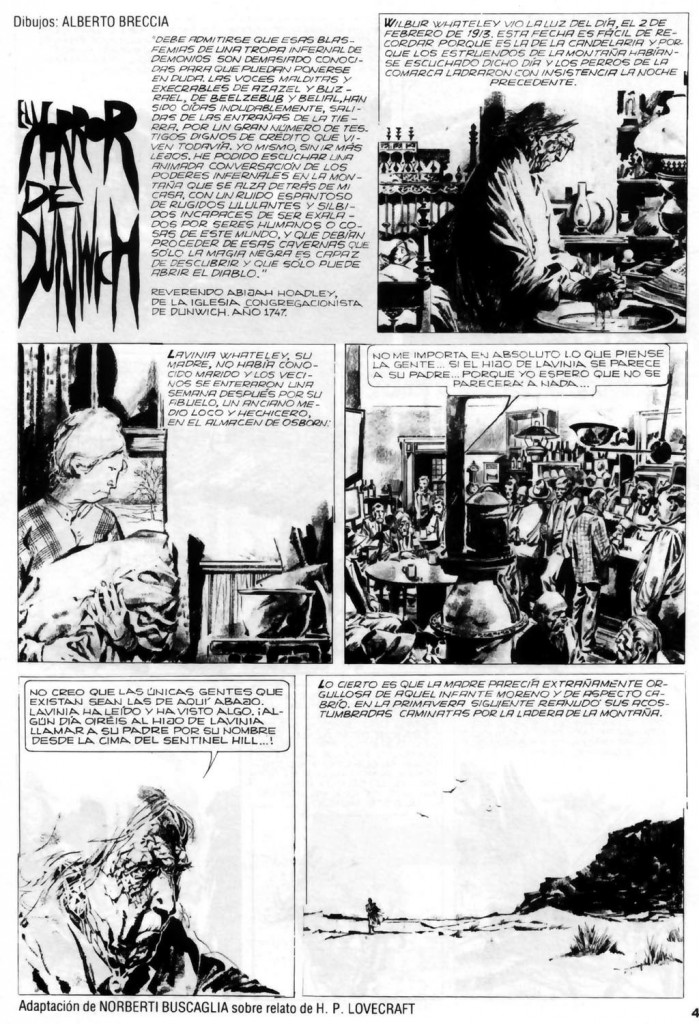
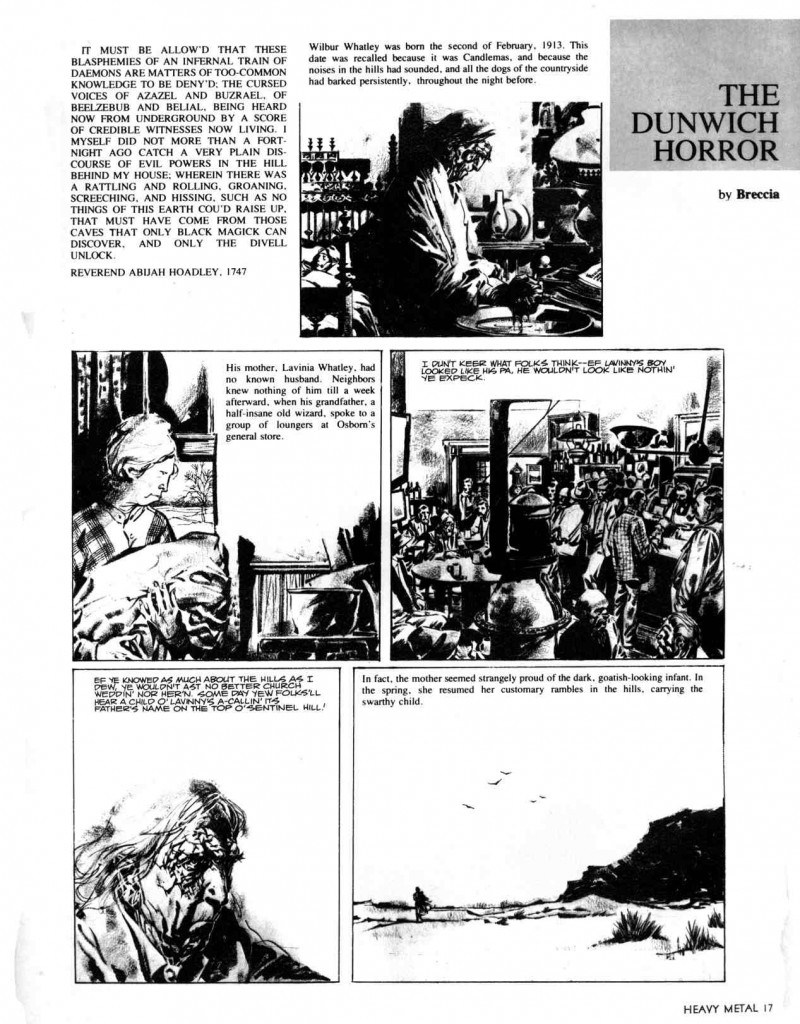
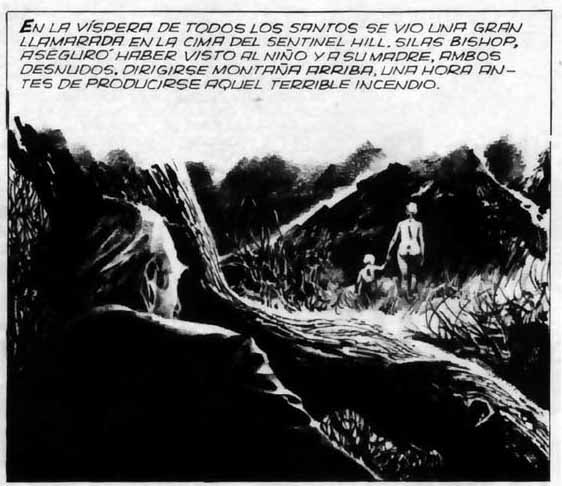
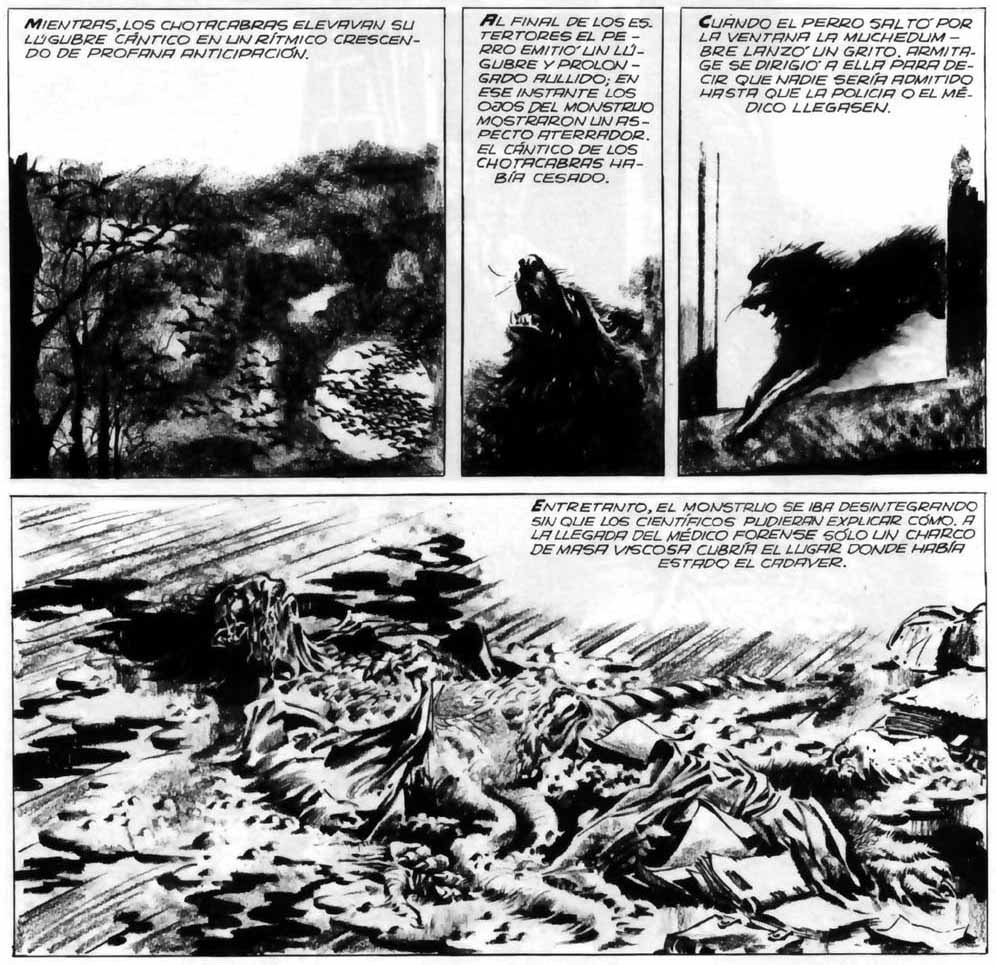
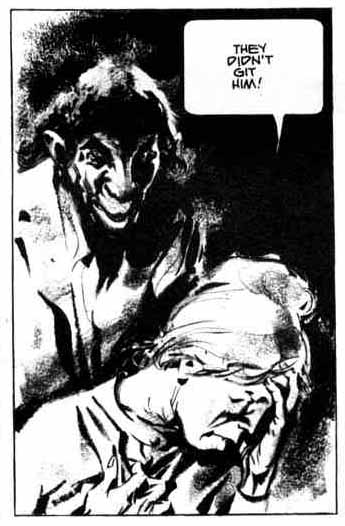
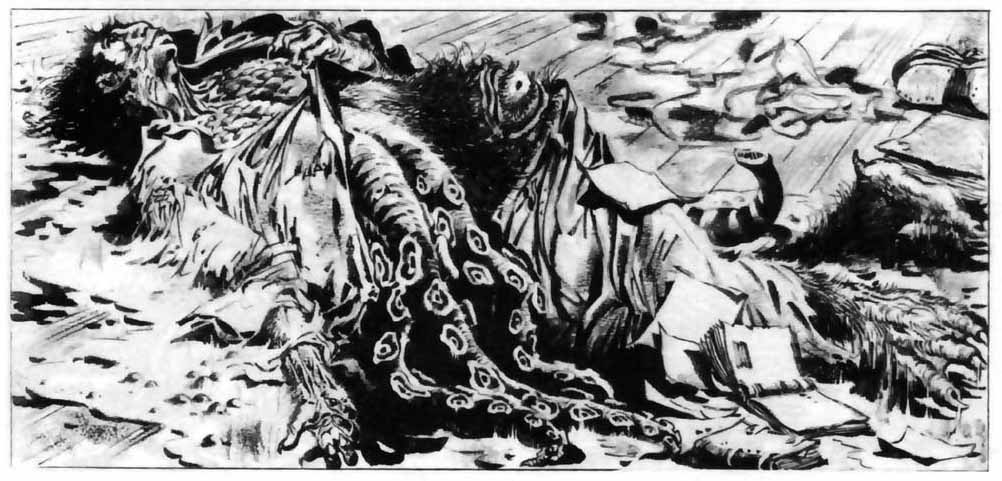
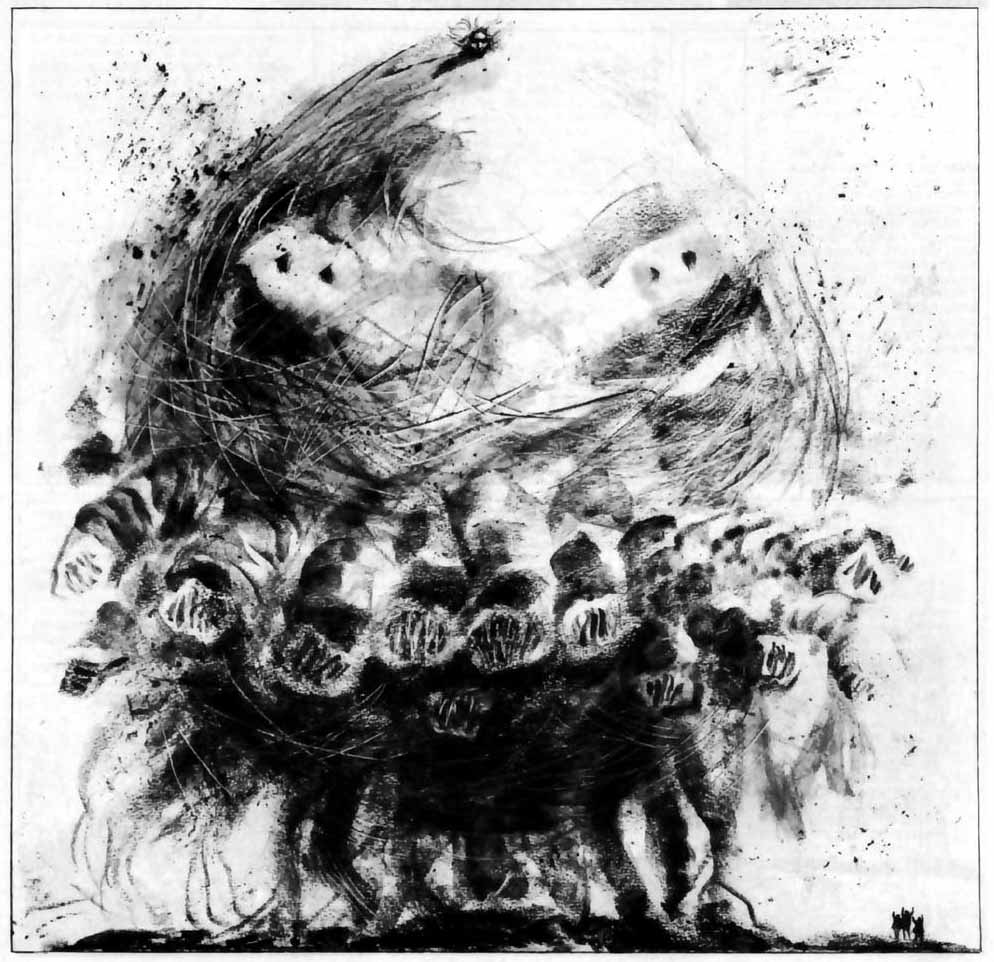
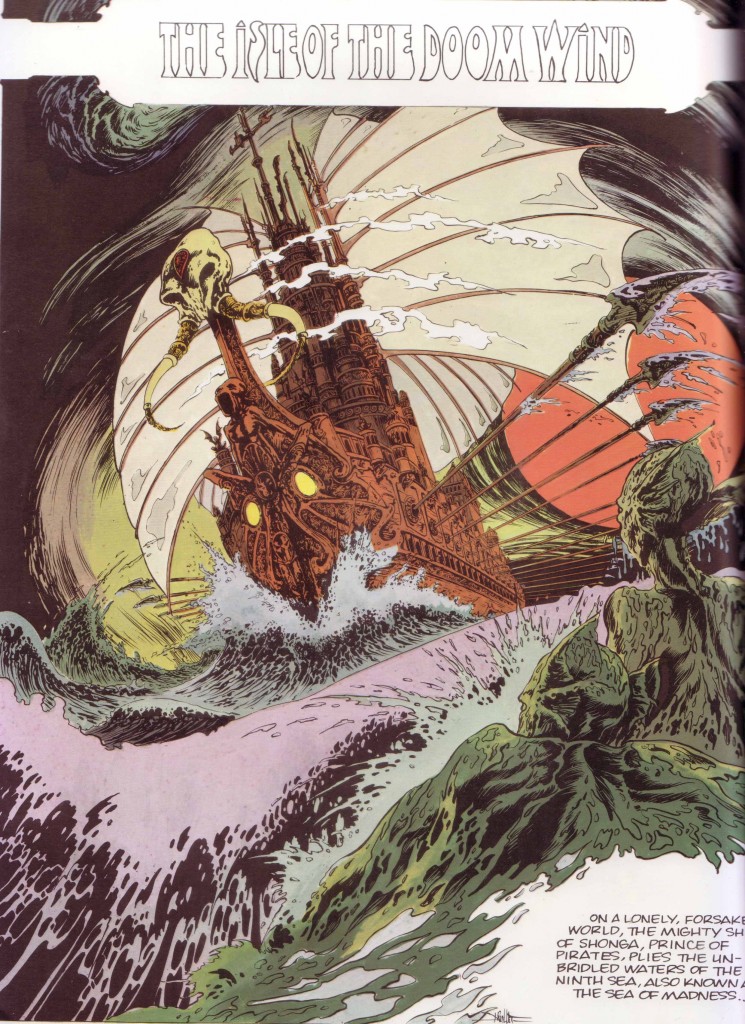
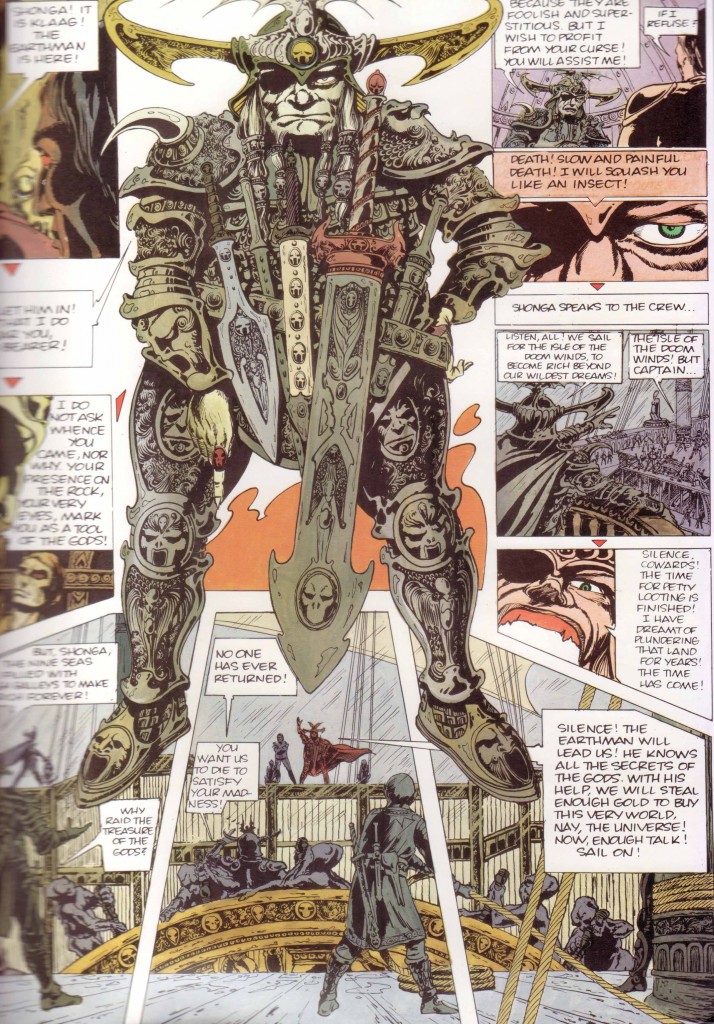
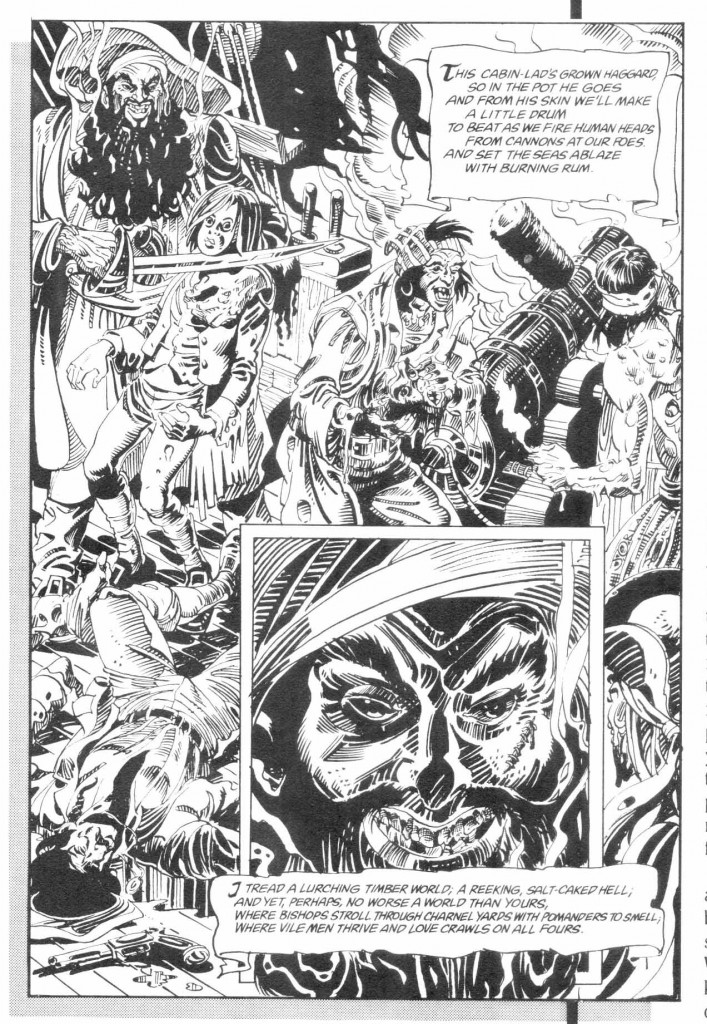

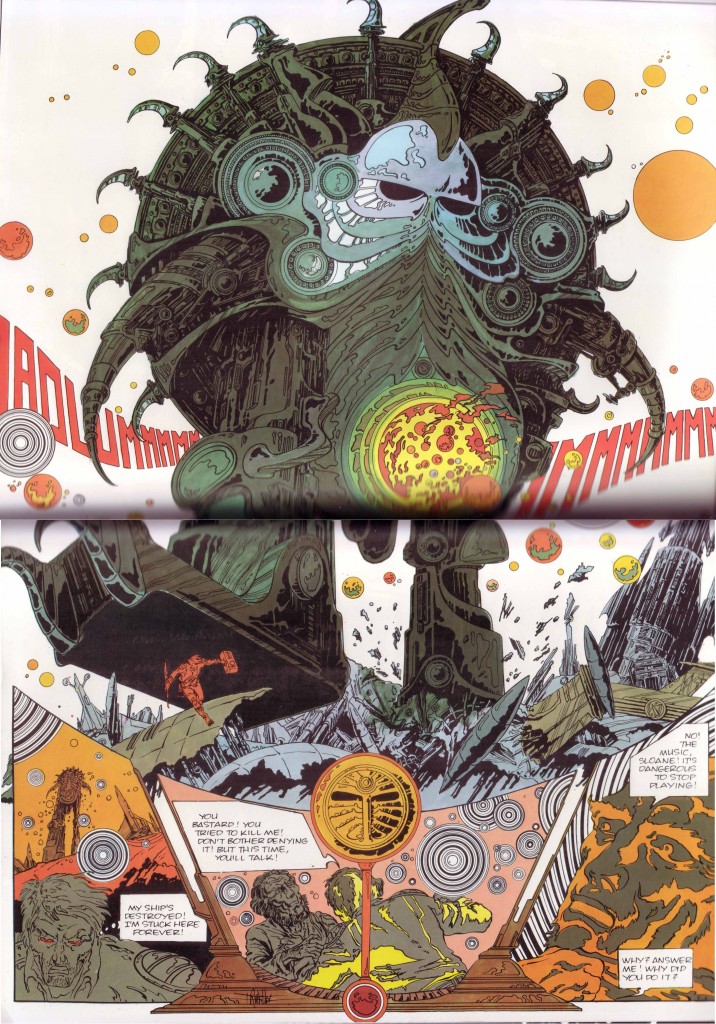

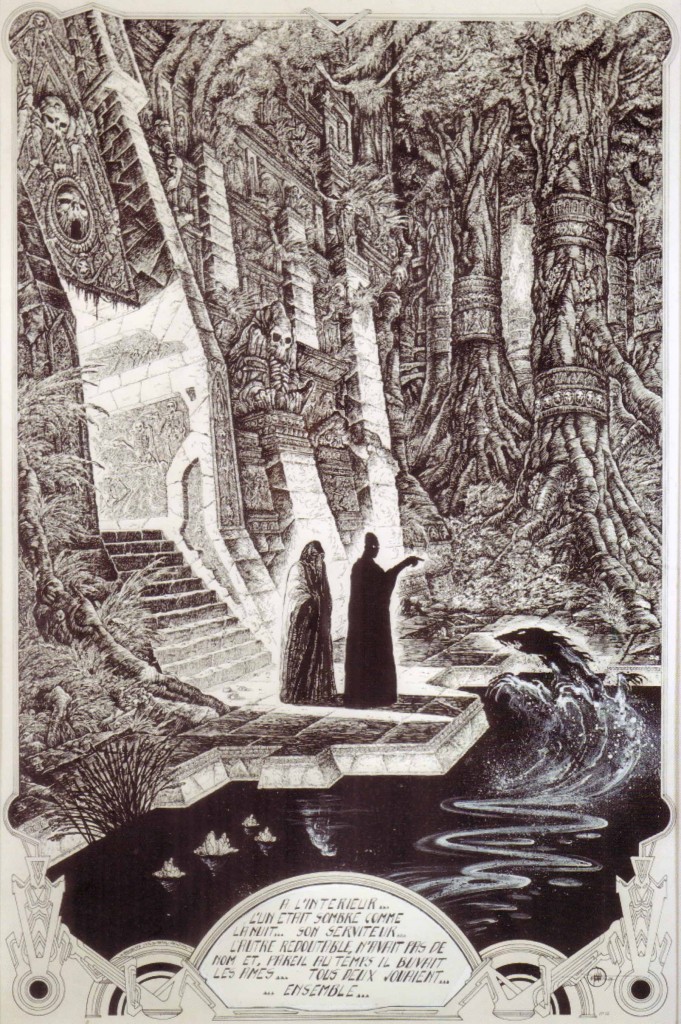
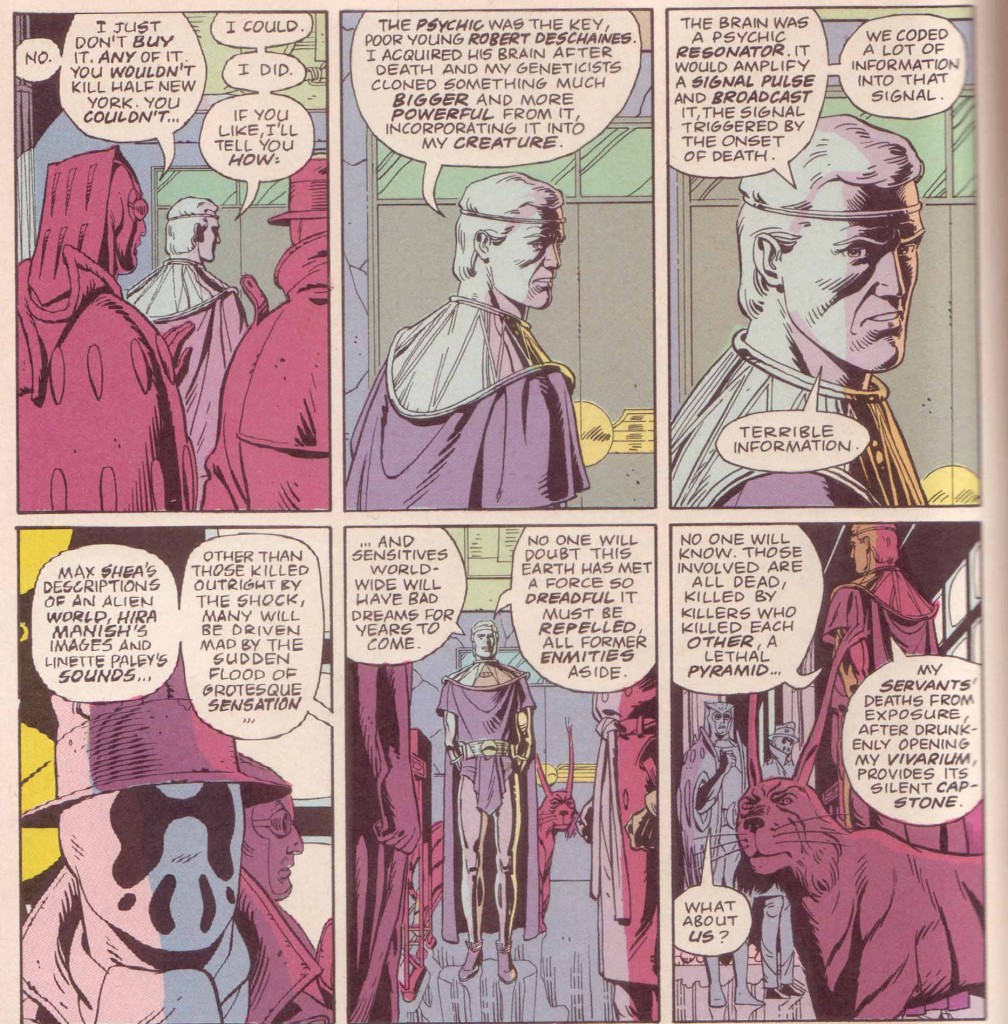
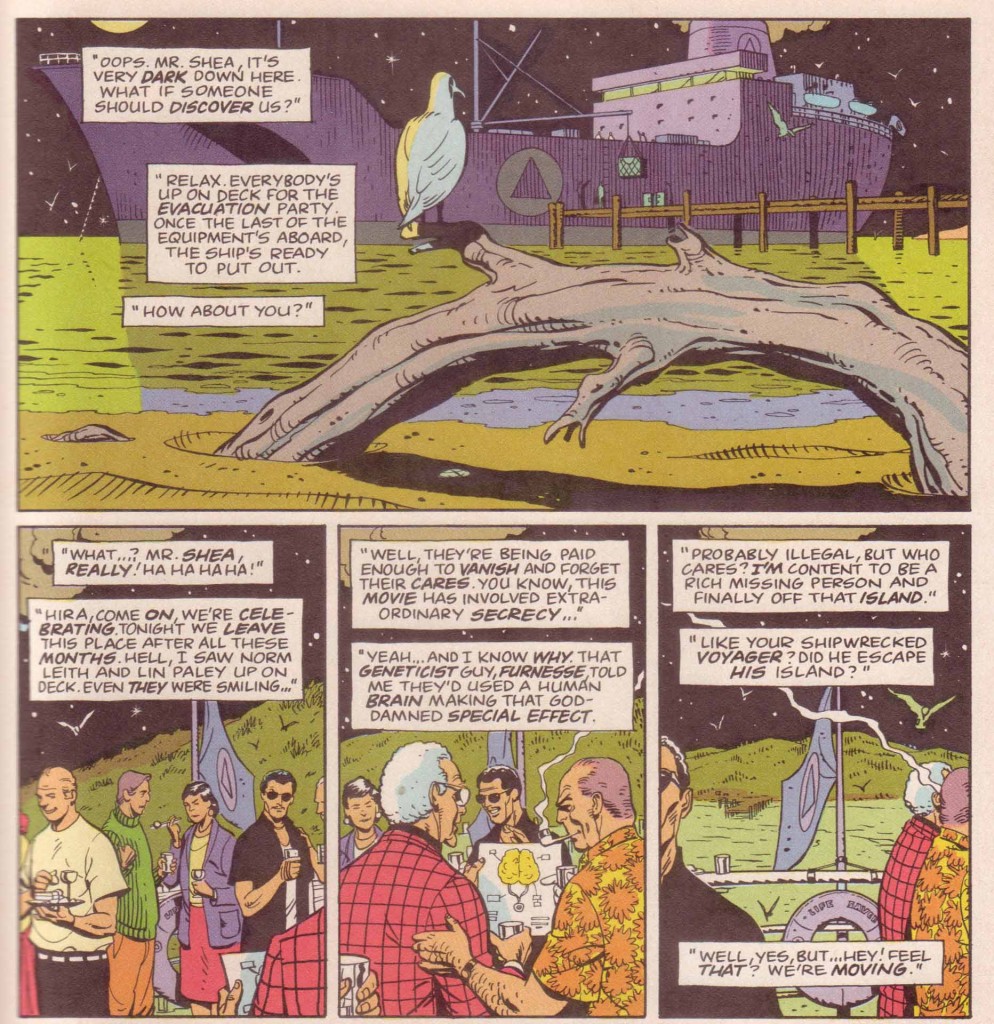
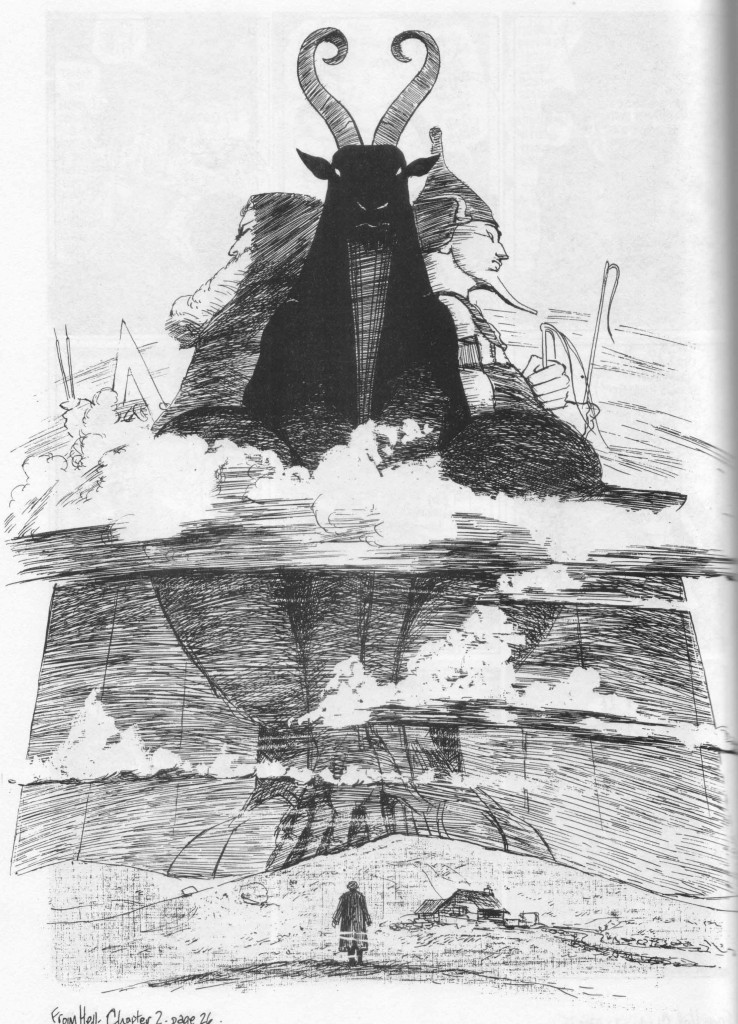
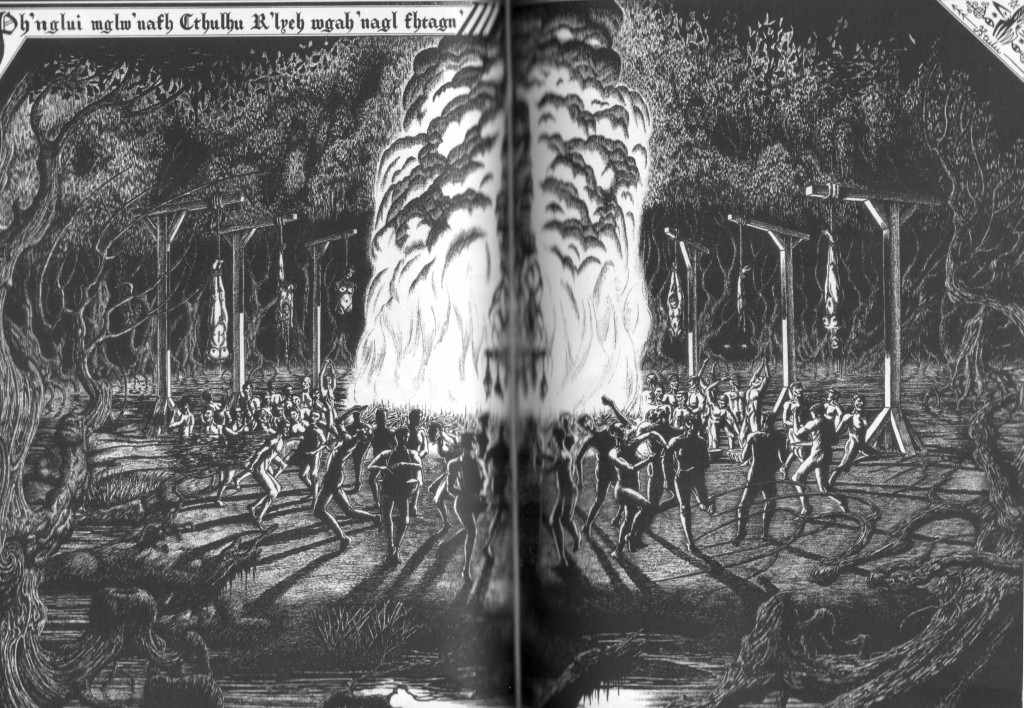

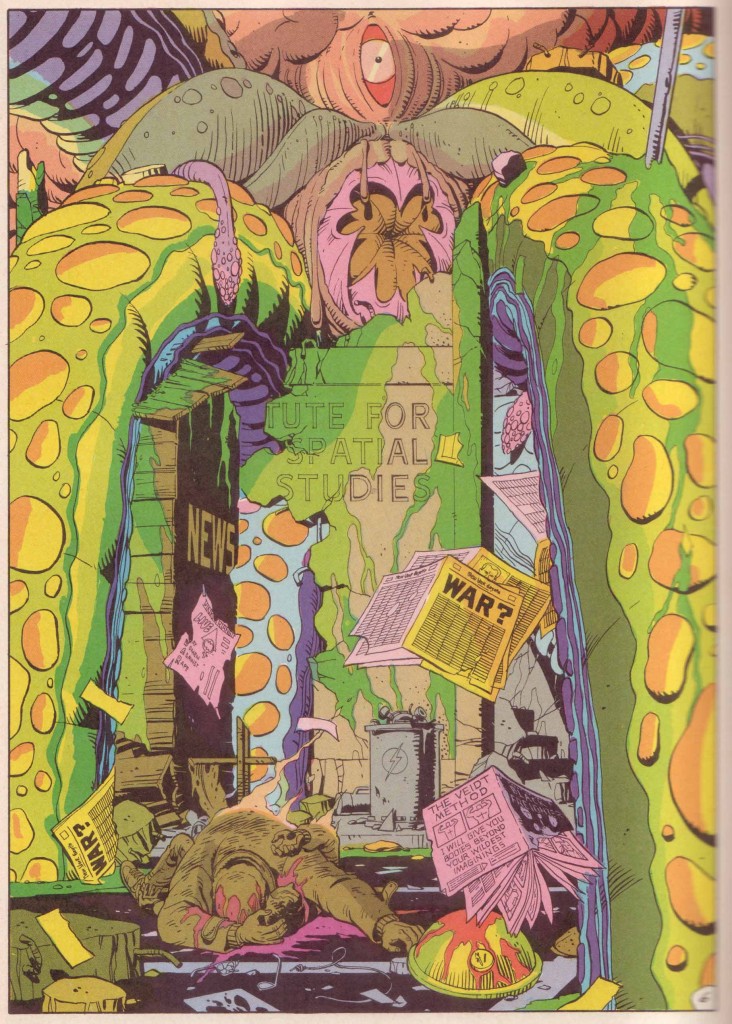
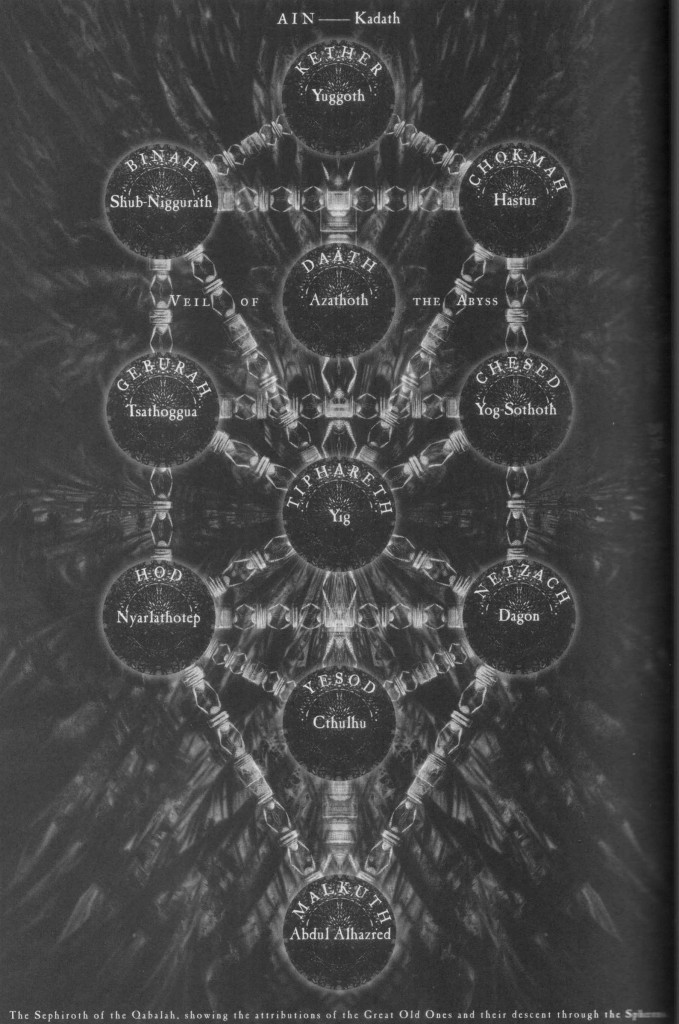

So…is Neonomicon worth reading? You’ve sort of intrigued me now, but I’m still hesitant….
Love that Eddie Campbell illustration.
Interesting article, Suat! It seemed like you were going to do more of the literal adaptations but I think you are dead on with the Druillet and Moore associations.
Knock yourself out reading the unspeakable book, Noah. Maybe you’ll be able to write twice as much when you grow that second head. Heh heh.
Noah: I think Neonomicon might make you angry. Some people have got mad at it because, guess what, Moore abuses another female protagonist in print again. You don’t get the full effect because of the quality of the art (a bit distanced) but it’s arguably his vilest moment as far as his depictions of violence against women are concerned. I believe Jog’s article on Neonomicon sees Moore as the rape victim and his oppressors the comics companies etc.
As for the overall effect of the story, I would say borrow rather than buy. Don’t waste time on The Courtyard comic though. It’s fairly pedestrian.
Noah: I read part of Neonomicon (when they were discussing it at ComicsComics), and I thought it was horrible on multiple levels. But, as you know, I don’t like horror (though I’ve enjoyed my far share of Lovecraft stories).
It’s certainly not Moore at his best or most innovative. More like a bowel motion. Still it might have a tinge of interest for Lovecraft fanatics. Care to elaborate on the various levels of horribleness, Derik?
It was ugly, repulsive, and stupid.
But maybe it got better in future issues…
Oh, the Neonomicon, I skimmed that bit because I hadn’t seen it and thought Noah wanted to read the Necronomicon and made a typo…I guess you’re safe with the other.
It’s one of those books that way more interesting to talk about than it is to read. Most definitely not one of Mr Moore’s best – but well worth giving a try.
Collected all the best things said about it at the bottom of this:
http://islingtoncomic.blogspot.co.uk/2011/12/neonomicon.html (all of them worth a read).
If you haven’t then I’d say you should – it feels like one of those books that everyone should try at least the once.
Really interesting, Suat. Those Druillet images make me want to check him out, moderation etc. be damned, but it doesn’t look like anything is readily available in English?
A few other Lovecraftian comics: have you read Ito’s Uzumaki? That one descends at the end into a Cyclopean freak-out, with the maddening sublime and what have you. Meanwhile, his Gyo plays on a different Lovecraftian theme, viz. that seafood is really icky. That’s a glib description, but I do mean seriously that Gyo has the same Lovecraftian sense of marine life as alien and psychologically unsettling.
The most Lovecraftian comic I’ve ever read, however, is one that doesn’t adopt any of his surface details (nameless horrors that unhinge the mind etc.): Cerebus #299. There’s a nauseating, suffocating dread that suffuses that issue, and it springs from the very same emotional source as Lovecraft’s, namely a moralised disgust for the perverse, unnatural Other. Given his own politics, Moore is not interested in reproducing Lovecraft’s predominant affect, but that’s not a problem for Sim who just subs Woman in for Non-White. So even though it’s not overtly Lovecraftian, it feels more like Lovecraft than anything else I’ve ever read, intoxicating but morally toxic.
Lovecraft’s repulsive other can often be read as the feminine, too. Works very well for Innsmouth, for example….
I thought Neonomicon was definitely worth reading. It does get better as it goes along… I agree that the rape stuff is not for the faint of heart and a little old in the Moore oeuvre by now (to put it mildly), but I think it was quite a bit better than some of the other latter-day Moore stuff. It’s an interesting counterpoint to the similar storyline in LoEG Century as well.
Also, this was a very cool article Suat.
Oh yeah, I didn’t really mean to imply that Lovecraft wasn’t disgusted by women — they’re icky too (Moore’s giant squid vagina is relevant here) — just that he was more disgusted by the lower races, which isn’t so much Sim’s concern…although, come to think of it, that Cerebus issue does have a pretty straightforward reading in terms of miscegenation.
I think Lovecraft’s racism and misogyny is pretty much a single giant bolus of loathing. Degeneration is a sexual as well as a racial monstrosity; the falling away from manhood is definitely falling away from *man*hood, into a slimy racialized unmasculine. The homophobia is in there as well…the Innsmouth look, indeed.
Jones: Actually, quite a lot of Druillet is available in English but most of it can only be found in back issues of Heavy Metal. The 6 Voyages of Lone Sloane and Chaos are both available in book format. I think Heavy Metal published Gail, Yragael, Salammbo, Vuzz, , Urm, and Delirius 1 but I last read those issues 20 years ago so don’ take my word for it. Of these Gail, Yragael (Moorcock inspired), and Salammbo are probably the most visually impressive. I still remember some of the images after all these years. And I did warn you about the stories right?
I never thought of Ito as a Lovecraft freak but you’re right. Even Uzumaki has that Shadow Over Innsmouth feel to it. And you must be the first person to suggest that Sim’s misogyny is as fascinating as Lovecraft’s racism – there must be an article in that. I don’t get that intensity, virulence, and outright revulsion from Sim though. Houellebecq writes that there are only 2 substantial female characters in all of HPL’s oeuvre (and they’re like aliens when they do appear) but I never bothered to check.
So you’re suggesting that the Watchmen Squid-Vagina is also supposed to create a psychic wave of misogyny cycling back through time?
Eric: I’m curious, in what way is the “rape stuff” in Neonomicon better than some of Moore’s latter day stuff (and which latter day stuff)? Just wondering.
There’s a couple of books of comic adaptations of Thomas Ligotti’s work (Titled The Nightmare Factory) which I haven’t read, but Ligotti often wades around in Lovecraft’s work in ways that seem like fresh developments instead of the usual fannish pastiche, so they may reward investigation.
Well, the really heavy, cloying, affect — virulent and intense, as you say — of Sim’s misogyny only comes through in that second-last issue. But it’s a doozy when it comes. Earlier on, Sim’s misogyny is not overtly driven by emotion; he takes great pains to present it as rational. Indeed, he dresses up the essential differences between Man and Woman in that old pantomime outfit of Reason v. Emotion. This is, I think, partly why it’s plausible to read much of the actual text of Cerebus as belying Sim’s own interpretation and stated ideology. Because he’s trying to present that ideology as purely rational and factual, he doesn’t do a very good job of making his women look bad; quite the opposite, really.
His outright repulsion by women starts to appear around the middle 200s, during a sequence where the Mary Hemingway analogue narrates a tedious story about the Hemingways’ trip through Africa. The intent seems to be that, through this story, the reader too will come to be repulsed by Woman’s a rebours degeneracy, but the story signally fails to hit the mark IMO. #299 is way nastier and way more emotionally successful (albeit abhorrent).
Aaron: Thanks for the suggestion. The contributor list on those comics (except for Bill Sienkeiwicz and Ted McKeever) is a bit iffy though. Can’t find the comics in the local library so maybe someone trustworthy can chime in as to their quality.
Jones: With that kind of high praise, I think I will have to actually read Cerebus #299 (I collected all the issues but never bothered to touch the last few ones).
Two caveats: it’s been a while since I reread that issue; and you’d probably better read at least a few of the immediately prior issues to understand Cerebus’ state of mind and what he’s waiting for.
But, other than that, if “as obnoxious as Lovecraft” is high praise, then have at it!
“… Druillet, an artist who has yet to show any devotion to moderation, logic or good sense to this day.”
A description which is a good fit for Jack Kirby as well. The two illustrations which border the above quoted statement evoke Kirby and Steranko quite a bit. Though I like those two illustrations better than anything I’ve seen of Kirby or Steranko.
I’ve wondered in the past who influenced who. I always assumed that Druillet saw and was consequently inspired by Kirby’s work but James seems to indicate (in his “Kirby: Approaching the Threshold” article) that in one instance Druillet influenced Kirby (in The Hunger Dogs). I presume he got this from an interview (?) but maybe James can chime in if he’s still reading. Here’s the quote:
“…Kirby’s appreciation for Phillipe Druillet from his sojourns to Richard Kyle’s well-stocked comic shop.”
The partial scan of a Druillet interview from The Jack Kirby Collector #34 indicates that Druillet was a fan of Kirby’s Fantastic Four. Also, see Metron’s Mobius chair in the first Druillet image above.
By the by, as with Kirby in his later years, you can see some weakening in Druillet’s drawing in his Lone Sloane: Delirius 2 album. But it’s not half as bad as the book makes it appear. I’ve seen the B/W original art and there’s little doubt that the color scheme (or printing?) muddies Druillet’s lines. And Druillet worked very large in these recent pages – 47 by 39 inches – which is larger than a Hal Foster Prince Valiant. It’s some of the largest comics OA I’ve seen.
I don’t feel up to dragging out all of my Kirby stuff to find the exact quotes, sorry, but roughly, Kirby went into Kyle’s comics shops and found Druillet’s books…in the early seventies, those would be the editions in French. Kyle specifically said that Kirby looked through them then bought them, saying something like “this stuff I like”. Druillet has acknowledged Kirby’s influence on his work and it can be clearly seen. Look at the Tales of Asgard from Thor 144 for instance…when I first saw Druillet, I thought of that strip. It is my observation that Kirby reciprocated, though, I saw that the influence of Druillet’s elaborate borders is not only in the mutated production of Hunger Dogs, but a Druilletesque approach is also present as early as in the opening sequence to Mister Miracle #2.
…which would make it a non-Druillet influence? Thanks for the info. Also, Wikipedia seems to indicate that the “The Throne of the Black God” (where Druillet’s cosmic chair appears) was first published in 1970 in Pilote #538 (trustworthy?), but Kirby’s Metron and his Mobius chair first appeared in 1971. I’m too stingy to spend money on The Jack Kirby Collector to find out how the influence (if there was one) worked out in that instance though.
I said Mister Miracle #2, not New Gods. And I meant by Druilletesque that it wasn’t just borders but the splash of Overlord as well. Kyle was one of the earlier Americans to promote European comics here….his shop certainly stocked the albums. So Jack may have seen Druillet’s stuff as early as the late sixties.
And TJKC never said anything about Jack being influenced by him….as I said, that is my observation.
Pingback: Comics A.M. | Convention organizers fight to save Javits Center | Robot 6 @ Comic Book Resources – Covering Comic Book News and Entertainment
Suat,
Bad pronoun use by me. It’s not that the “rape stuff” in Neonomicon is better…just that Neonomicon itself is better than alot of recent Moore stuff. Works like Promethea and Black Dossier (and even Lost Girls to some extent) are kind of plotless wonders, more interested in voicing particular philosophical positions than actually telling a story. I think Neonomicon has the old Swamp Thing creepiness, and the “mystery-plot” structure of Watchmen that drives the story (and perpetuates a creepy atmosphere). To some degree maybe it’s just that I welcome the return of “darkness” to Moore’s work, as it is the darkness that kind of built his name and which he’s still very good at. I liked LoEG: 1969 for the same reason…It has a creepy vibe, a mood of darkness and disillusionment at which Moore excels. I don’t think there’s anything great about Jacen Burrows’ art, but I did think Neonomicon had something to recommend it. Part of this may be simply that I never really got into Lovecraft and so the overt references to it don’t impact me much (so, it doesn’t feel like a crappy knockoff to me, even though it may well be just that).
I liked the Courtyard short story too…but I only read it in the original prose version…not the comics adaptation.
I see. I think there’s something to what you say. As Lovecraft homage, Neonomicon is probably more interesting than most straight adaptations out there. If anything, knowing the Lovecraft references increases the appreciation because it’s not a slavish and unthinking homage. Which might be seen as damning with faint praise but there you are.
However, I’m sort of puzzled by his persistent choice of Jacen Burrows for his Lovecraft comics and his short story adaptations. Burrows also did the art for “Recognition” (adapted by Antony Johnston from a Moore story) which also has a nasty-ish Satanic rape scene. A writer of Moore’s stature probably has a lot of choices artist-wise. Maybe it was the path of least resistance. I wonder if he bothered asking John Coulthart about doing some of these comics for instance.
I actually don’t think Moore chose Burrows at all. I could be wrong, but the stuff that came out with Avatar seems mostly to be stuff Moore wasn’t planning on publishing. Avatar asked him if he had anything lying around that they could publish and he gave them Neonomicon. He was planning on not publishing it at all, since he had decided it came from an “angry place.” He reread it and reconsidered when they asked him for something. The Yuggoth Cultures stuff was all old 2000 AD stuff for the most part…and the Courtyard was an adaptation of a prose story. Avatar asked Moore if they could adapt a bunch of stuff that wasn’t comics as comics (his songs and poems, in addition to The Courtyard). They gave The Courtyard to Burrows, which then made him a natural choice for the “sequel” when it came to them. So, to sum up, I don’t think Burrows was a Moore choice, though he has been complimentary of the result.
That all sounds very plausible and some of it even familiar. So basically Moore is treating all this Lovecraft stuff (including Neonomicon) like his junk pile. Not even bothering to choose his own artist? Or maybe he did give Avatar’s choice of Burrows the green-light. Interesting that this throwaway work seemed to work better for you than his more dedicated stuff. Maybe sometimes working from the gut works better than thinking too hard.
——————————-
Aaron White says:
There’s a couple of books of comic adaptations of Thomas Ligotti’s work (Titled The Nightmare Factory) which I haven’t read, but Ligotti often wades around in Lovecraft’s work in ways that seem like fresh developments instead of the usual fannish pastiche, so they may reward investigation.
———————————
I’ve read Ligotti in prose (brilliant) and those two “Nightmare Factory” collections of comics adaptations (excellent). Indeed, Ligotti’s bits of Lovecraft influence are occasional and lightly deployed. Which is the best approach, I think; Lovecraft’s “voice” is so strong, his Cthulhu-schtick so famed, that it’s all too easy to come across as pastiche/unintentional parody.
At the one World Horror Con my Significant Other and I were able to attend (Atlanta, 1995), the Guest of Honor was the superb “horror writers’ horror writer” Ramsey Campbell, a jovial Brit wearing a t-shirt aping the MacDonald’s Golden Arches but saying, “Marijuana.” In a frequently-hilarious speech (sharing the stage with Caitlin R. Kiernan, an outstanding talent in her own right) he told of selling his first horror story, heavily in the HPL vein, to an anthology edited by August Derleth. He exuberantly acted out the tale’s finale, its hapless protagonist in frenzied delirium, spitting out a stream of Lovecraftesque gibberish as his sanity sputtered out in a final blaze: “Shub-niggurath! Yog-Soggoth! Hast’r! Ph-nglui mglw’nafh Cthulhu R’lyeh wgah’nagl fhtag!” (Or words to that effect.)
The audience was practically rolling on the floor with laughter. …How I wish that had been filmed!
“From the documentary on author H.P. Lovecraft – Ramsey Campbell remembers his first encounter with the weird tales of the Cthulhu mythos”: http://www.youtube.com/watch?v=sv4Vp9ZdNgk
So anyway, to capture the spirit of HPL in horror prose is more effective to my tastes. As in the outstanding “There Are More Things” — http://www.contrasoma.com/writing/borgeslovecraft.htm — by the great Borges, who found depths and inspiration in workers of looked-down-upon genres, like Chesterton. Why, even the Lovecraft stories I prefer, such as “The Colour Out of Space,” are non-Mythos tales.
Yet it’s for the Cthulhu Mythos, its blending of SF and horror to produce cosmic horror that he’s most influential and remembered. (“The universe is not only queerer than we imagine, it’s queerer than we can imagine, as the British physicist Haldane put it.)
My recollection is also that Moore’s Avatar stuff came from his junkpile, and Avatar (known for its explicit violence, gore and sexual content {usually violent} in its art) was only to happy to exploit it. There’s a house style in their more “literary” horror comics (ie, Moore and Warren Ellis) that’s the clear-line, almost cartoony Jacen Burrows-type line that seems to mimic the kind of effect one would see in CGI in a horror film. It’s quite the opposite of the moody, oppressive and atmospheric art of a Bernie Wrightson or John Totleben. I find Avatar’s house style to be slickly repulsive, like looking at a teenage boy drawing something gross for fun. You can tell their artists read a lot of Image comics growing up.
As for Moore, Promethea worked mostly because of JH Williams III. A lesser artist would have made the extended lecture on magic that was the last dozen or so issues even more tedious. The last comic of his that I really liked (even though it apparently ripped off several other sources) was Top Ten (and its accompanying Smax miniseries). The “easter egg” stuff in there was fun, but those comics were actually tightly plotted and Moore showed a real facility with serialized police procedural material. It was both lighthearted and serious in turns, a nice balance for a writer whose actual humor comics always left me a bit cold.
That Smax mini series had such godawful art though…but I agree that Top Ten looks better and better in retrospect….
I’m a fan of Top 10 and the first 2 vols of LoEG (I like this latest vol. so far as well…it was Black Dossier which I thought was a dud). He’s been kind of hit and miss over the last decade or so, to my mind…which is certainly better than almost any other superheroey creator (most of whom are simply miss and miss at this point). I read one interesting interview in which Moore talks about writing Neonomicon in the aftermath of his breakup with DC (over the V for Vendetta film, I think…, but it might have included the Watchmen film-related stuff). He was so angry about it that he went to a dark place and Neonomicon was the result. Looking at it, he thought that it was just too gruesome and replete with sexual-violence and he wouldn’t use it at all. Obviously, he changed his mind (assuming the story isn’t bs to begin with), but I guess I wouldn’t mind him going to a dark place with more frequency AND choose his own artist (I guess From Hell maybe is one possible result). I kind of feel like LoEG:Century is actually repurposing of the same material (again, the plotline is to try to plant a moonchild…and sexual violence is involved in that happening)—and that too works when it goes to dark places (as in the middle chapter)–but Kevin O’Neill is obviously far preferable to Jacen Burrows.
In general, if it’s coming out from Top Shelf, it means Moore has authorized it in some way… If it’s from Avatar, it’s junk-drawer stuff (or stuff he wants us to think is from his junk drawer).
If it’s from DC, it’s a cash-in reissue.
————————
Rob Clough says:
…The last comic of his that I really liked…was Top Ten (and its accompanying Smax miniseries). The “easter egg” stuff in there was fun, but those comics were actually tightly plotted and Moore showed a real facility with serialized police procedural material. It was both lighthearted and serious in turns…
———————–
“Top Ten” was indeed great! Dunno about “lighthearted,” though. I’d say (ever the Quibbler), funny in the fashion that Mark Twain prescribed (“The humorous story is told gravely; the teller does his best to conceal the fact that he even dimly suspects that there is anything funny about it”) and serious, even touching.
————————
Noah Berlatsky says:
That Smax mini series had such godawful art though…
————————-
Tch! It was perfectly fine. More cartoony that the “Top Ten” art ( http://1.bp.blogspot.com/-7pBfJGZ162I/TyJs7zkVqvI/AAAAAAAABsA/9oTqOqyqQrE/s1600/smax.jpg , http://images.wikia.com/marvel_dc/images/4/47/Smax_2.jpg ); appropriately so, since this is a fairy-tale world (only one where the hero ends up as his sister’s lover, as is the custom there). And the weird visage of the nuclear-powered dragon was remarkably original: http://d1466nnw0ex81e.cloudfront.net/iss/600w/459/474591/9635161_1.jpg .
(Interview with Zander Cannon, the “godawful art”-ist: http://www.comicbookgalaxy.com/bigtimeattic.html )
————————-
eric b says:
..In general, if it’s coming out from Top Shelf, it means Moore has authorized it in some way… If it’s from Avatar, it’s junk-drawer stuff (or stuff he wants us to think is from his junk drawer).
————————–
(“This is a job for…the Quibbler!”) Um, you mean authored, right? ‘Cause the Avatar comics were hardly “unauthorized.”
Now, his Top Shelf comics have been wholly scripted by Moore. While Avatar has done adaptations of Moore prose stories, performance work, even songs. And, because Moore chose not to something in comics to start with, hardly means he considered it “junkpile,” inferior work. (I.e., “Voice of the Fire” http://www.themodernword.com/reviews/moore_fire.html .)
Why, two of the finest comics ever created (no, I’m not exaggerating; and anyone who disagrees is wrong), “The Birth Caul” and “Snakes and Ladders” were Eddie Campbell adaptations of Moore performance pieces he thought could not be translated into comics. Utterly brilliant.
The one where I’ve been able to read the original prose work, “Hypothetical Lizard” ( http://en.wikipedia.org/wiki/Alan_Moore%27s_Hypothetical_Lizard ) was a pretty damn faithful adaptation, and an outstanding work. Alas, both scriptwriter Antony Johnston ( http://en.wikipedia.org/wiki/Antony_Johnston ) — who has adapted various Moore works for Avatar and artists Lorenzo Lorente and Sebastian Fiumara — got nary a mention on the front cover of various editions of the book.
(Johnston on adapting Moore: http://www.comicbookresources.com/?page=article&old=1&id=4328 )
Pingback: Adapting Lovecraft « TENTACLII :: H.P. Lovecraft blog
I’ve just seen the new flick ‘Prometheus’…as Lovecraftian a movie as can be seen. I’ve got a review coming up.
‘Cabin in the Woods’ is also a Lovecraft rift.
I think some semi-famous director (del Toro?) wanted to adapt At the Mountains of Madness but decided against it because of Prometheus.
del Toro still very much wants to do it, but it was going to be a very expensive film for the hard R rating he wanted. He was going to use Tom Cruise to help get financing, but the studio pulled the plug. I don’t get much of a chance to promote this, so here’s my interview with the director. (It took place while the movie was still happening.)
I’m coming to the party late here, but just wanted to second James about the Druillet and especially the Watchmen comparisons.
Incidentally, that pirate illustration from Watchmen is, I believe, by Joe Orlando, not Gibbons.
Yep, absolutely correct Matthias. The pirates are by Orlando. I spotted that mistake a few weeks back but have no idea why I didn’t correct it. I think sheer laziness will do as an excuse. I shall change the caption at once…
Pingback: The MIB and the King in Yellow | ZeroKnight
Pingback: TBA 2016/08/15-08/21 - The Black Aether